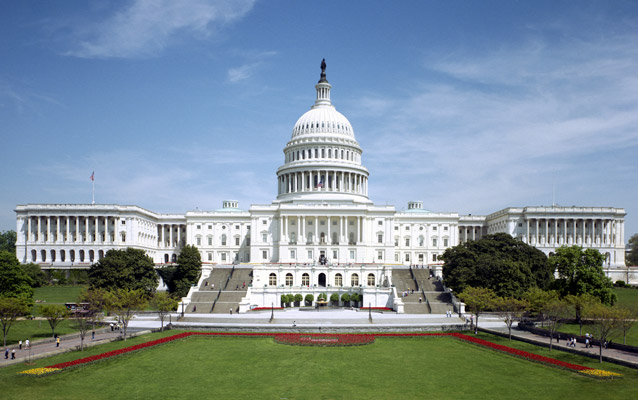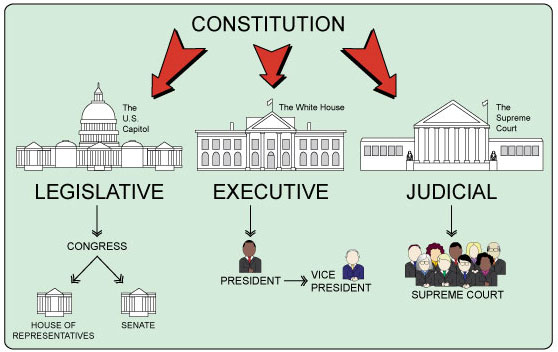


Founding Principles: American Governance in Action is an online series produced by Bowdoin College and narrated by Government Professor Andrew Rudalevige that provides an introductory overview of American government and politics. Each resource includes a breakdown of enduring understandings, an overview of content, a list of covered foundational documents and Supreme Court cases, ideas for extending learning, suggested classroom activities, related vocabulary words, and student viewing guides with comprehension and critical thinking questions. With a rich study of primary sources such as the Declaration of Independence, the Constitution, and the Federalist Papers, and an emphasis on promoting civic engagement and participation, students explore the foundation of our democracy and the importance of citizenship.
The U.S. Constitution establishes the structure and powers of the federal government, the means of selecting persons to serve as public servants within the government, methods for the revision of the Constitution itself, the rights of the American people, and certain limitations on the powers available to the government. At over 230 years old, it is the oldest document of its kind still in use today.
The Constitution establishes three branches of the U.S. federal government in order to separate power and enable a system of checks and balances. The legislative branch is responsible for the passage of laws, the executive branch is responsible for the execution of the laws, and the judicial branch is responsible for settling questions of interpretation or applicability of laws. More information about the three federal branches, as well as checks and balances, can be found in the boxes below.
The Bill of Rights contains the first ten Amendments to the Constitution. It guarantees civil rights and liberties, sets rules for due process, and establishes that all powers not allocated to the federal government are to be reserved for the American people or to the States.
Read transcripts of the Constitution and Bill of Rights, and learn about the history and meaning of these founding documents:

Executive Branch
The executive branch of the federal government is responsible for carrying out or executing the laws of the United States. The executive powers of the federal government are vested in the President, the Vice President, the Cabinet, and other officials. While the President has unique powers assigned by the Constitution (such as signing or vetoing legislation, commanding the armed forces, and granting pardons), much of the work in the executive branch is carried out by federal agencies, departments, committees, and other groups.
Learn more about the executive branch:
Learn more about presidential history and facts:
Legislative Branch
The legislative branch of the U.S. federal government is composed of Congress and its supporting agencies. The principle responsibilities of Congress include the creation of laws, declarations of war, and oversight of the executive and judicial branches. It is composed of two chambers, the Senate and the House of Representatives.
The House of Representatives is composed of 435 voting representatives who each serve two year terms and represent a specific district within their state. District boundaries are drawn by state governments, and the number of representatives from each state is determined by population. Responsibilities unique to the House include the origination of legislation and the power of impeachment.
The Senate is composed of 100 Senators, two from each state, who serve six year terms. Responsibilities unique to the Senate are approving Presidential appointments and trying impeachments brought by the House of Representatives.
Members of the House and Senate each serve on committees in order to manage the thousands of bills that are introduced in Congress every year. Each committee includes members from both parties, and focuses on a specific legislative area, such as the budget, foreign relations, or finance.
Find out more about the legislative branch:
Guides to the legislative process:
Guides to finding and understanding legislation:
Judicial Branch
The judicial branch of the U.S. government is tasked with settling matters of interpretation, applicability, and the constitutionality of our laws. There are three levels of federal courts: U.S. district courts try cases locally, the appellate courts hear appeals from the districts, and the Supreme Court is the highest of all courts in the federal judiciary. Each subsequent court has the power to overturn the decision of the previous court. The Supreme Court hears appeals from other federal courts and is responsible for deciding whether laws violated the Constitution or whether executive actions are unlawful. Occasionally, it will hear a new case, such as one between states. In addition to the federal courts, the judicial branch also includes the agencies and organizations that support them.
Find out more about the judicial branch:
Learn more about the Supreme Court:
Looking for direct access to each branch's key publications? Start here:
Other helpful resources about the federal government: